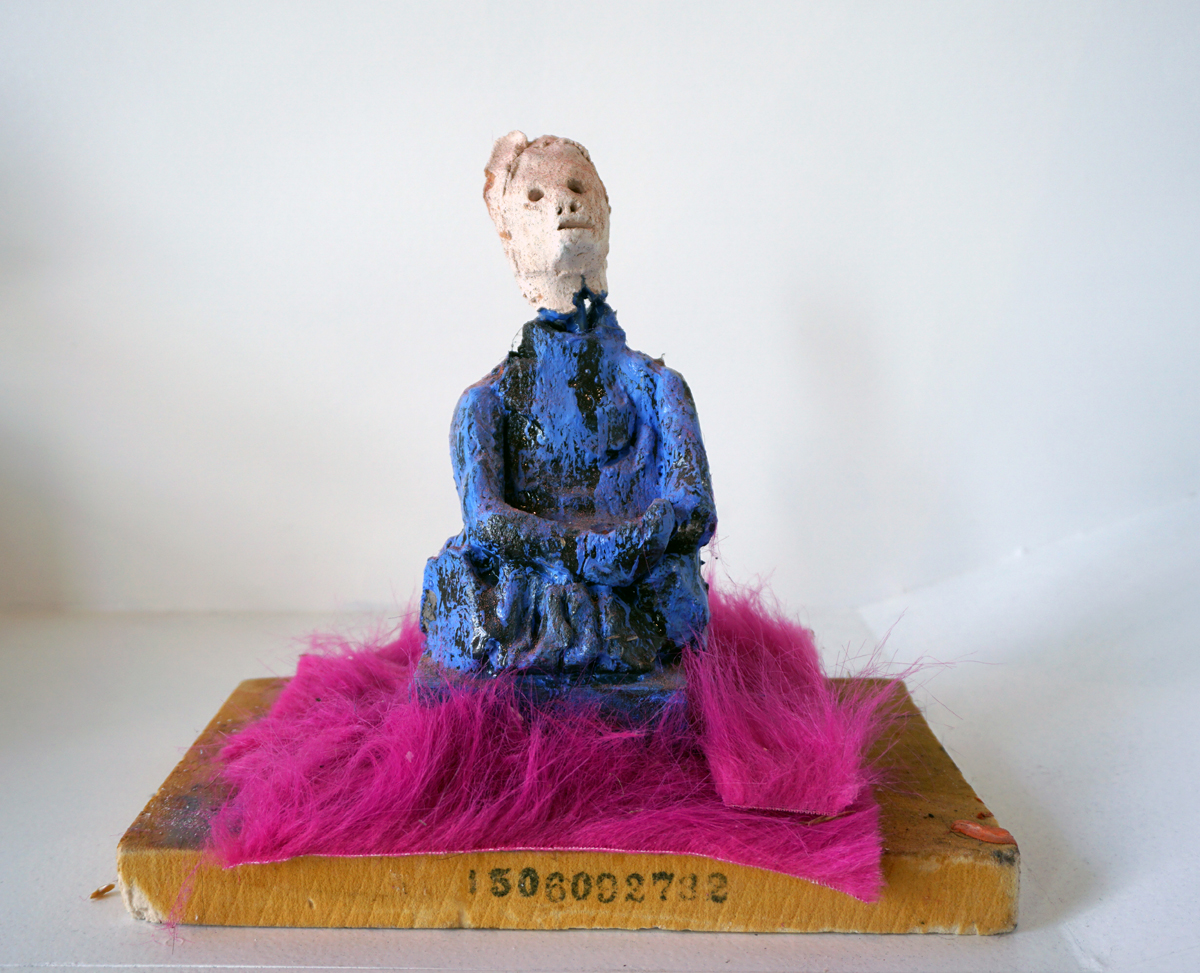
Painter/sculptor Andrea Patrie doesn’t give a fuck if you’re uncomfortable.
Her sculptures at the new Fourth Element Gallery are creepy, corpsey, totemic things, naked, their faces animalistic, more suggested than represented. The figures rest in a Buddhist stance amid garish pink carpet (Clay Series #1) or are presented as a sitting male figure with a vulvic slash between its legs, nylon smearing its features like a rapist’s mask (Clay Series #2), while another resembles a tar baby in white-face, a spike stabbed through its head (Clay Series #4). Powerful, despite their diminutive size, they seethe with both an erotic and a malevolent tension, as if they’d better be worshipped or they’re coming after you. Revere if you must, but as with the Zuni fetish doll in Trilogy of Terror, they make me want to run away screaming.
Patrie’s wall-sized, oil-on-canvas paintings are primarily female—girls wearing masks, posing impatiently; mugshot self-portraits; drawings of winsome young women caught in thoughtful repose—but have some of the same gender-indeterminate, unsettling sexuality of her sculptures. Gold Tooth Mother Fucker resembles a man on a bed wearing yellow panties, our eyes drawn to the flat surface of his crotch, with his long hair, small, flat face and muscular body, part Virginia Woolf’s Orlando, erotically charged stare down and androgynous freak show. Odalisque II references Ingres’ painting, but the nude figure pictured could be a boy or a girl, the soft, pale curves here as beckoning as the sultry concubine in the original.
Patrie’s particular skill as an artist is not her ability to paint a face—most of the people pictured, even when she’s painting herself, look as if they’re wearing masks—but her blocks of color that so defiantly capture skin tone, place and attitude. The artist’s solo show “In Front of a Dirty Double-Mirror They Found Me” has been curated with gusto by Laura Black, and while her confrontational images don’t promise many dentist office sales, they’re a fresh voice and vision grabbing our collars and demanding our attention.

A block over, Orange County Center for Contemporary Art’s (OCCCA) exhibition “It’s Time” promises an “uncensored look at the Time’s Up and #MeToo movements,” but it never feels as ground-breaking as Patrie’s work. Curated by Anuradha Vikram, the group show incorporates both feminist and anti-sexual abuse/harassment artwork, which, while not mutually exclusive, have differing agendas.
The title of the show—whose first piece is three riot shields emblazoned with “My Body My Business,” “MeToo” and “Pussy Grabs Back”—promises something fierce and uncompromising inside, but it’s more reactionary than revolutionary, the kind of show a snarkier person might label “typical of Orange County” art and politics. Fists get thrust into the air and tired terminology like “patriarchy” gets thrown about, but there are precious few ideas or solutions. As with last year’s “Art As Protest” at OCCCA, “It’s Time” feels mostly like a generalized shrug, a wallowing in despair, promising but not delivering.
There are exceptional works that rise above the rhetoric and restatement, however, offering us new ways of seeing: The limited palettes of the pastel-and-colored-pencil portraits of a child and an adolescent girl in Vivian Patton’s Up ’Til Now reveal an emotionally stifled youth, ominous charcoal fingerprints obscuring the children’s mouths, as if choking off their speech. Above the two is a portrait of a middle-aged woman, skin tones warmer and the image more hopeful, the black fingers off to the shadows at her side. Away from her face, mouth fully revealed, she is free and ready to tell her story.
Vanessa Filley’s powerful color photograph of a black woman in Civil War-era clothes, a #MeToo patch stitched to her blouse like a scarlet letter, brings to mind the rape and mistreatment of slave women, recent circumstances near the border reminding us that the United States’ separation of parents from their children is nothing new. Joseph Liatela’s installation ode to Joan of Arc, a redwood post blackened by fire, wrapped with chains and padlocks, revels a little too much in academia-speak, but it’s a moving tribute to the French heroine burned at the stake in part for cross-dressing—a rape-prevention strategy on Joan’s part—as well as to every trans man or woman who stepped away from and left behind the body they no longer wanted.
Ashley Obregon’s The Healing Project is the show’s most effective piece: three fine-art prints of two women and one man, their personal stories of sexual assault printed out, below that an audio recording of them narrating their ordeal (which was missing the day I was there). The trio’s words are succinct, brave, blunt and powerful, summoning up what’s most integral to the movement: breaking the silence. Accompanied by white hooks in the wall where the missing recorders should be, the unused plastic clasps feel like unintentional fingers there to catch the trio if they fall.
“Andrea Patrie: In Front of a Dirty Double-Mirror They Found Me” at Fourth Element Gallery, 210 N. Broadway Ave., Santa Ana, (657) 232-0002; www.facebook.com/4thelementgallery. Open Tues.-Sat., 11 a.m.-7 p.m.; Sun., 11 a.m.-5 p.m. Through Aug. 1. Free.
“It’s Time: An Uncensored Look at the Time’s Up & #MeToo Movements” at the Orange County Center for Contemporary Art, 117 N. Sycamore St., Santa Ana, (714) 667-1517; www.occca.org. Open Thurs.-Sun., noon-5 p.m. Through Aug. 11. Free.
Dave Barton has written for the OC Weekly for over twenty years, the last eight as their lead art critic. He has interviewed artists from punk rock photographer Edward Colver to monologist Mike Daisey, playwright Joe Penhall to culture jammer Ron English.

